- Seneca Nation Of Indians To Vote For New President
- NJ, Canadian Mohawks Block Data Site From Illegal Net Bets
- Native American Imagery On Yale-Dartmouth Football Program Draws Criticism
- State Record Set For Tribal Gaming Revenues
- FBI Investigating Tribal Housing Authority
- Shoshone Rose Casino Re-Opens With New Hotel
A Letter from the Publisher

Shekóli. The Standing Rock Sioux nation has an ongoing dispute with Energy Transfer Partners, the owners of Dakota Access Pipeline, LLC. It is also involved in a legal and policy debate with the United States Army Corps of Engineers. So why is the state of North Dakota employing facial recognition technology, roadblocks, and militarized police to corral, control and arrest Native Americans? How is it that a state government is coming down aggressively on the side of a corporation against a great number of people it ostensibly is supposed to represent?
Rhetorical questions, to be sure, and ones that anyone with a working knowledge of North Dakota’s treatment of Indians for the past 175 years would hardly find extraordinary. Still, in this day and age the tactics deployed in North Dakota, and reported in this week’s lead feature, “A Crackdown In Progress,” are truly disturbing. In the face of antagonistic, threatening behavior and display of weaponry reminiscent of when this generation’s Lakota great-grandparents were slaughtered for their land, Native water protectors have displayed nearly constant non-violent behavior.
Yet the governor of the state insists on ramping up police presence to “protect” its people, very few of whom are near the camps or the pipeline project. Officers of the law are using facial recognition and license-plate reading cameras to record the comings and goings of the protectors while the officers refuse to identify themselves and display no badge numbers or ID. Meanwhile, the camps near Standing Rock are under constant surveillance from helicopters, and authorities have stonewalled the press about who is operating them.
Crazier still, the state has decided to borrow $6 million to pay for this heightened and extreme police presence—all of which has ratcheted up tensions among neighbors of Standing Rock who are just trying to co-exist. It’s hard to reconcile the actions of the state with its obligation to defend and follow the will of its people. Clearly, government civil servants are present to guard company machinery. Yet after the machinery does its job and moves on, it is state land that will be gouged and scarred forever.
The federal government has called for a reevaluation of current practice to help establish policies of the future. It’s not too late for North Dakota to join in.
NΛ ki wa,

Ray Halbritter
ICT News
Cities Join Opposition To Dakota Access Pipeline
Nineteen U.S. city governments have passed resolutions or written official letters opposing construction of the Dakota Access pipeline, the Standing Rock Sioux Tribe announced on October 13. These cities join more than 300 tribes that have objected to the routing of the pipeline under the Missouri River.
The municipalities include Seattle, Washington; Minneapolis and St. Paul, Minnesota; Portland, Oregon; Asheville, North Carolina; and Sitka, Alaska. Urbana, in Illinois, one of four states through which the pipeline will pass, has also weighed in. In California, Berkeley, Santa Barbara and Oakland have dispatched anti-pipeline resolutions.
The resolutions by city and municipal councils express solidarity with the Standing Rock Sioux in particular and Indigenous Peoples in general. They reference treaty rights, broken federal promises, the common need for safe drinking water and a burgeoning of distrust of oil companies’ ability to ensure pipeline safety.
“Nearly all of St. Louis’s drinking water is sourced from the Missouri River, and approximately half of Missourians receive their drinking water from this river, as well,” stated the resolution of St. Louis, Missouri. It cited recent oil spills, “including the release of 80,000 gallons of oil near Tioga, North Dakota in October 2013” and “1,000,000 gallons of tar sands crude in Michigan’s Kalamazoo River in July 2010.” These incidents and others, the resolution declared, “demonstrate the danger for downstream communities, fish, and wildlife from oil from pipelines such as the Dakota Access.”
“Ithaca sits upon Haudenosaunee Confederacy land, and we live with daily reminders of the horrors of treaties unhonored,” wrote Ithaca, New York, Mayor Svante Myrick. “Every day on my way to City Hall I pass Cayoga and Seneca streets with the knowledge that the modern foundation of our streets was built upon an ancient burial ground. If we can play even the smallest role in preventing that history from repeating itself, it would be an honor.” http://bit.ly/2dapZUJ
HUD Allots $56 Million For Native Community Development Projects
By MARK FOGARTY
The Department of Housing and Urban Development (HUD) has allocated $56.5 million to 77 Native American communities to improve housing conditions and stimulate community development. The money, administered through the Indian Community Development Block Grants program, will fund construction projects and local jobs.
Tribes in 22 states received funding. The Navajo Nation in Arizona, New Mexico and Utah received the largest allocation, of $4.2 million, to help extend power lines to 10 locations that lack them. The Tohono O’odham Ki:Ki Association in Arizona received the second-largest grant, of $2.75 million; it plans to build 10 new single-family homeownership units to help reduce a housing waiting list of 180 families.
The Pueblo of Zuni, in New Mexico, will receive $2.2 million to rehabilitate 39 owner-occupied housing units and make them more energy efficient. The tribe, through its housing authority, is contributing $735,000 to the project, which will create up to 25 full-time jobs.
The All Mission Indian Housing Authority of the La Jolla Reservation in California is using $605,000 to provide the west side of its community with water. Near Auburn, Washington, the Muckleshoot Housing Authority will use its $500,000 grant to improve 10 housing units, making them more energy efficient and creating jobs in the process. In Oklahoma, the Cheyenne-Arapaho Tribe will use an $800,000 grant to build its Concho Head Start Center, which will serve 57 low-income children and their families.
Seven tribes received grants of $1 million apiece, among them the Blackfeet and the Confederated Salish and Kootenai tribes in Montana and the Oglala Lakota in South Dakota. http://bit.ly/2dIz207
Pickup Plows Into Native Protesters In Reno, Injuring Five
A pickup truck plowed into a crowd of mostly Native demonstrators in Reno, Nevada on October 10, injuring five and sending one to the hospital. Approximately 40 participants in the demonstration, organized by the American Indian Movement of Northern Nevada, were gathered under the city’s Reno Arch downtown to protest Columbus Day and draw attention to the conflict surrounding the Dakota Access oil pipeline.
Suddenly, witnesses said, a white Nissan pickup truck drove by, its occupants hurling slurs. Then it circled back and stopped; some of the demonstrators walked up to the vehicle and had words with the occupants. Suddenly the truck’s engine revved and the vehicle plowed into the group, sending people flying. The incident occurred at 6:41 p.m., police told the Reno Gazette-Journal.
Two men “drove into marchers after first being seen at the rally start point, driving by once shouting slurs, and then doubling back around to get in front of the protesters before driving into them,” reported Diana Heideman, owner of Wallflower Botanicals. “One elder, a grandmother there with her grandchildren, was hospitalized with injuries to her legs, a broken tailbone, and further tests pending.”
“This is a hate crime,” Quanah Brightman, executive director of United Native Americans Inc. told the Gazette-Journal. According to KOLO-TV, the driver of the pickup “stopped several blocks away and called police to provide his account of the events. He and his passenger were interviewed and are cooperating with the ongoing investigation.” http://bit.ly/2e78LoL
A Crackdown In Progress
Security forces play hardball with DAPL protesters
By MARY ANNETTE PEMBERBottom Line: Attack dogs, helicopters, surveillance technology and other means are increasingly being deployed to keep opponents of the Dakota Access pipeline in check.

The presence of armed authorities who stop and question motorists is increasingly unnerving.
Mary Annette Pember
If protesters against the Dakota Access pipeline (DAPL) construction near the Standing Rock Sioux reservation are covering their faces, it is with good reason. They don’t want to be identified by police forces that are using facial-recognition technology to spot people so they can press charges.
But the technology isn’t foolproof. Just ask Greg Grey Cloud of the Crow Creek Tribe in South Dakota. He was arrested on September 28 after voluntarily surrendering to North Dakota state investigators at the Morton County jail. He had traveled from the Rosebud Reservation in South Dakota after learning there was a warrant for his arrest; it alleged that he had committed criminal trespass during the now famous September 3 confrontation with DAPL security guards and their dogs. But at the time of the September 3 action, Grey Cloud was actually in Rosebud at a family barbecue.
“I think they are targeting Indians unfairly,” he said.
* * *
Grey Cloud’s experience reflects the growing determination of law enforcement authorities to counter the thousands of water protectors and activists who have descended on ground zero of the DAPL construction site.
The effort is being met with funding from Bismarck. On September 21, a North Dakota state panel voted to borrow up to $6 million from the state-owned Bank of North Dakota to support policing efforts, reported Forum News Service.
“The problem that we have, of course, is that these public safety needs are imminent every day,” said Gov. Jack Dalrymple. “We really have no choice but to protect the public with law enforcement.”
In Grey Cloud’s case, the criminal trespass warrant was based on surveillance video footage. Grey Cloud, a cofounder of Wica Agli, a traditional Lakota men’s society created to protect and support women, had previously traveled to Cannon Ball to visit the water protector camps. When he learned of his warrant, he presented himself at the sheriff’s office. There, he and his attorney were surprised to learn that the warrant contained a “no bond” stipulation requiring him to remain in jail overnight until his case could be heard the next day.
His warrant was dismissed on September 29, though “without prejudice”—meaning that authorities can revisit it at a later date if they choose. The Wica Agli office said they were “appalled” by the actions of North Dakota’s bureau of criminal investigation. “It is this type of institutional racism and racial profiling that is at the core of the struggles currently happening in North Dakota,” the organization said.
Opposition to tactics by police and private security firms is building on other fronts. The American Civil Liberties Union of North Dakota, for instance, has issued a statement of solidarity with the Standing Rock Sioux tribe. The organization has called upon Dalrymple to demilitarize the state’s response to peaceful protesters and actions against the Dakota Access pipeline, and decried the governor’s decision to declare a state of emergency.
And on September 28, Amnesty International USA asked Morton County Sheriff Kyle Kirchmeier to investigate the use of force by private contractors, remove blockades and discontinue use of riot gear when policing protests and protesters.
The various camps near Cannon Ball now appear to be under almost constant surveillance from helicopters and planes. The aircraft also follow water protectors during actions carried out against the pipeline.
North Dakota law enforcement authorities said they did not know who might be paying for the cost of the two helicopters that are an almost constant presence. However, North Dakota Highway Patrol (NDHP) spokesperson Sgt. Tom Iverson acknowledged that the plane is a part of the NDHP and has air-to-air communications with the choppers. Both Morton County spokesman Rob Keller and Iverson, however, said the aircraft are not directed by law enforcement.
Georgianne Nienabor claimed otherwise in an October 3 article for Huffington Post. After filing a Freedom of Information Act request, she learned that helicopter owner Arnold Johnson Jr. had admitted to investigators that the registration number on one of his aircraft had been altered. This was “due to threats made against registered owners of aircraft being flown supporting law enforcement during the pipeline protests near Bismarck.” The alteration of registration numbers, however, is a serious violation of FAA regulations.
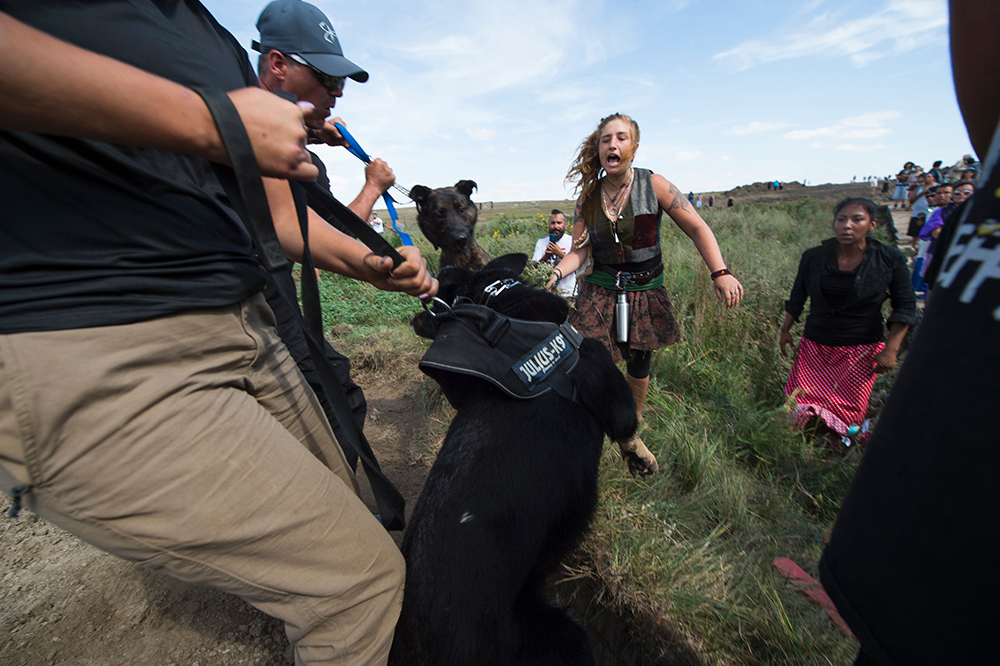
The attack dogs that were dispatched on September 3 remain a vivid icon of Dakota Access counter-protest measures. ROBYN BECK/AFP/Getty Images
The roadblock south of Mandan that had detoured drivers around highway 1806 near the protectors’ camps has now been downgraded to an “informational checkpoint.” However, the presence of fully armed National Guardsmen who stop and question motorists traveling south is unnerving for many. In fact, law enforcement is collecting information on each vehicle that passes the checkpoint and is creating a database, said Tom Goldtooth, executive director of the Indigenous Environmental Network.
NDHP spokesman Iverson also said that a license plate reader has been utilized at the traffic information point but added that he is unaware of its capabilities or how any data are stored.
According to Keller, local residents fear the protectors and have reported crimes such as theft of hay, trespass and fence cutting. He was unable, however, to provide a listing or number of reports, describing them as unofficial.
“These are not formal reports,” the deputy wrote of the alleged crimes. “Locals are not willing to give their identify for fear of retaliation.” Instead he provided a document describing examples of intimidation as gathered by “a Morton Country Deputy who is making visits with area residents.” .
Despite the lack of substantiated reports, Morton County Sheriff Kyle Kirchmeier has asked for help in policing from the National Sheriff’s Association. The move, said the Association’s past president Danny Glick, is unprecedented.
“When we get a call from Sheriff Kirchmeier, we will be ready to assist,” Sheriff Glick of the Laramie County, Wyoming, sheriff’s department, told the Bismarck Tribune.
* * *
Fear seems to come easy these days in North Dakota for longtime residents. Much of the trepidation seems fueled by speculation, rumor and the unknown.
When ICTMN contacted a non-Native North Dakotan who also opposes the pipeline, the woman refused to comment for fear of losing her job and insisted that her name not be used. A woman who answered the phone at Rusty’s Saloon and Bar in the unincorporated town of St. Anthony said she and her family live in the area because they like the peace and quiet.
And there is still plenty of peace and quiet to be had; neighbors live miles apart in this great expanse. St. Anthony is located near the pipeline, and like many towns here, has no paved roads. It is a place where a line of more than three cars provokes comment.
Patrons of Rusty’s stepped outside on September 28 to watch a line of about 75 cars pass by after drivers participated in an action against the pipeline. The bystanders appeared grave and concerned as the dust churned up by the unwelcome visitors settled over them.
“Certain things have been happening to some of the neighbors,” said the woman who had answered the phone at Rusty’s (and who stated that she does not own the bar). “An elderly lady was frightened by protesters in her yard that refused to leave. A guy on horseback rode onto our land and declared that this was his land. Ranchers are having a tough time getting out to cut their silage because the roads are blocked. Everyone has a right to have their say, but getting everything into a big uproar doesn’t help anything.”
On the protector side, rumors also feed a sense of unease. For instance, a crop duster dropped liquid during a protest on September 28; authorities reported that the plane dumped vegetable oil as a means to let other aircraft know it was in the vicinity. But many insisted that the plane had dispensed nerve gas or some other dangerous agent.
The woman from Rusty’s expressed concern about all the newcomers. “They [the tribe and camp organizers] keep asking people to come,” she said. “I don’t know what’s going to happen.”
She added that she merely wants “the whole thing to be over.” http://bit.ly/2d1kcMj
Sunshine, Bugs—And Fish
In North Carolina, a most unusual way of raising trout
By THERESA BRAINEBottom Line: Solar power and bugs are making a sustainable and financial difference for a veteran Native fish farmer.

Solar-powered trout feeders are technological centerpieces at Smoky Mountain Trout Farm.
Courtesy Sequoyah Fund
John McCoy (Eastern Band of Cherokee) is not only the sole American Indian trout farmer in North Carolina; he may also be one of the most innovative. The owner of Smoky Mountain Trout Farm, McCoy has equipped his farm with solar fish feeders for daytime feeding and installed solar powered bug zappers that supply his fish with insects for night feeding.
McCoy, a 45-year industry veteran, is coming to the close of his first season using these new techniques, which he hopes can help transform his trade and increase profits for both himself and his fellow farmers.
McCoy was able to experiment with these green techniques thanks to a grant from WNC AgOptions and a business loan from Sequoyah Fund, a community loan fund. In working with small businesses on a daily basis, Sequoyah Fund Executive Director Russ Seagle sees start-up costs as one of the most common challenges that entrepreneurs face. Similarly, initial costs for solar panel installation often present a barrier for business owners and consumers.
“The way John combined funding sources demonstrates his ingenuity and resourcefulness,” said Seagle. “We are happy that funds from our lending program could be combined with grant funds to make a significant bottom line impact in John’s business.”
McCoy’s approach is not only incorporating sustainable farming methods, it is increasing his bottom line. His energy bill has decreased by an average of $120 per month, and the addition of the insects into the fishes’ diet has decreased the amount of feed he uses. He estimates the bugs will offset his feed expenses by $5,000 annually.
“In trout farming your profit margin is determined on the cost of fish food,” he said. “With this setup, I’m able to offset that.”

“Our food sources will have to adjust,” says owner John McCoy. Courtesy Sequoyah Fund
McCoy initially purchased 5,000 pounds of fish in April, and with his monthly weigh counts, he estimates that he will sell 20,000 pounds at the end of October. Buyers are already lining up. There is a high demand from processors, but he could also sell to a stocking program. Both options would benefit the state’s economy, either by supporting the food or tourism industry.
McCoy also hopes these new techniques will benefit trout farmers. During his time in the U.S. Trout Farmers Association, he advocated for reasonable resale prices to help expand the market and support the trout farmers. “We see a lot of markup, but it’s not the farmers that are making all of that,” he said. With more competitive prices at the grocery store, he feels, more people would buy trout more often.
After he sells his current batch, McCoy will make some final calculations and determine exactly how profitable his new approach has been. Not only can other trout growers replicate his sustainable cost-savings model, he said, other types of farms—such as chicken or pig—can also use it.
Irrespective of how trout come to market, McCoy touts their health benefits, notably their high protein and Omega-3 content. With oceans growing more polluted and the land becoming more contaminated with pesticides, he feels, fish in general and trout in particular will emerge as an increasingly essential food source.
“Our food sources will have to adjust,” he said. “The future is in healthy food that comes from waters that are clear and fields that are clean. And, that’s what we have in the Smoky Mountains.” http://bit.ly/2daKQTb
Bears Ears Alternative Goes Forward
But opponents cry ‘land grab’
By KIM BACABottom Line: Two sacred buttes in Utah may yet achieve national monument status. A recent House vote, however, does not augur well.
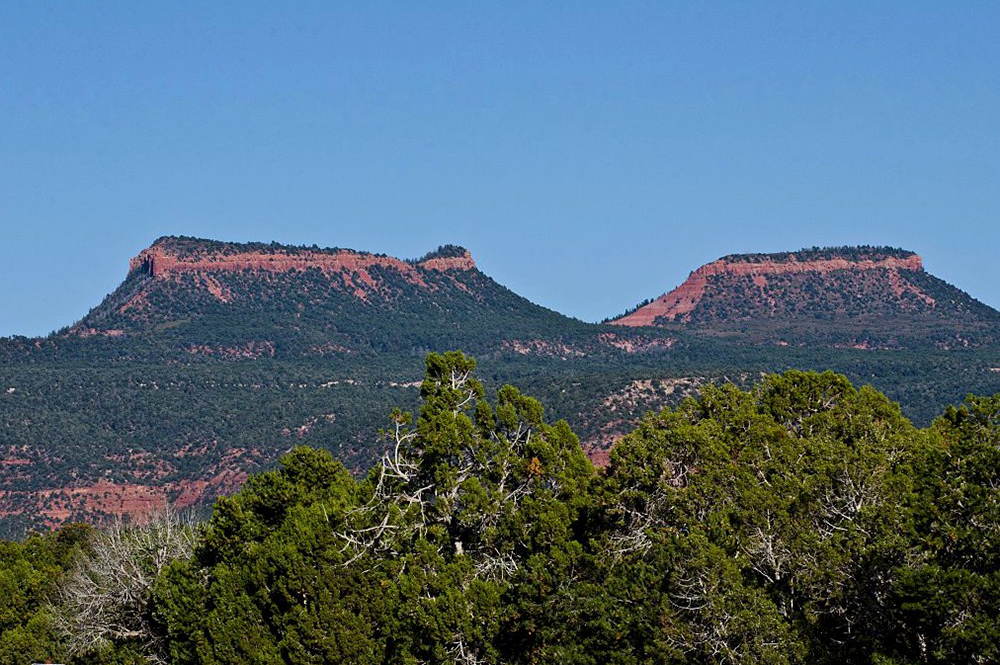
A vote on designating the Bears Ears buttes in Utah as a national monument is moving toward consideration by the full House of Representatives.
Getty Images
Amid considerable controversy, a House bill that is being touted as an alternative to an intertribal proposal to designate the Bears Ears buttes formation as a national monument is headed toward consideration by the full chamber.
The bill, known as the Utah Public Lands Initiative (H.R. 5780) and sponsored by House Natural Resources Committee Chairman Rob Bishop (R-Utah), passed the Republican-majority committee by a 21-13 vote on September 22.
But committee Democrats say the bill does not contain a tribal consultation component or protect half a million acres identified by the tribes in their larger Bears Ears designation request.
That larger request would set aside nearly two million acres of land in southeastern Utah for national monument status. By contrast, the Public Lands Initiative Act designates only about 1.4 million acres of federal land for “conservation and recreation” and would consolidate “certain federal and non-federal land; and provides for economic development within the State of Utah.”
Critics say the measure would open the land to natural-resources development and give a fair amount away to private interests. Committee Republicans rejected six Democratic amendments, including one by Raul Ruiz (D-California) that would have protected land, water, roads or other resources within the Uintah and Ouray Ute Reservation.
Calling H.R. 5780 “legislation that tramples over sovereignty and self-determination” and “a modern-day Indian land grab,” Ruiz said the Ute tribe was denied an opportunity to present their concerns in a formal hearing. He also said the bill was fast-tracked to avoid a hearing in the Indian, Insular and Alaska Native Affairs (IIANA) Subcommittee, where he is a ranking member.
“Without a hearing in the IIANA subcommittee we’re not able to fully discuss the true status of these lands within the Ute Indian Tribe’s reservation,” Ruiz said. “H.R. 5780 would be the first bill to take away these lands from these tribes. Attempting to justify taking away these lands based on misleading questions raised at the federal land subcommittee hearing last week is wrong.”
Located in northeastern Utah, the Ute are rich in oil and gas wealth. The Bureau of Land Management currently oversees land and minerals for sections of their land. But Ute officials say the land should have been placed under trust through the Indian Reorganization Act. They oppose the Utah Public Lands Initiative because it “proposes to take Indian lands and resources to fix Utah’s problems.”
Democrats have continually cited opposition to the initiative from area tribes. They have particularly noted that the bill excludes 500,000 acres of the Bears Ears region named after its two namesake 9,000-foot twin buttes. Residents consider the area sacred, as it contains more than 100,000 archeological sites.
Tim McClintock (R-California) countered that several area tribes have supported the Utah Public Lands Initiative and that a Navajo official—San Juan County Commissioner Rebecca Benally—agrees with them.
“The testimony that we received from the county commissioner called the claim of the Native American support for the Bears Ears monument campaign a sham,” McClintock said. “She says, ‘I’m here to help you unmask it.’”
But Ruiz disputed any suggestion that Benally speaks for the entire Navajo Nation. “Saying that one woman, this Navajo woman acting as a commissioner, using her as a token spokesperson for her tribal nation—that is wrong,” he said. “The Navajo Nation under their president and their council opposes this land grab and are in solidarity with the Ute Nation.”
The Navajo Tribe, the Ute Mountain Ute Tribe, the Uintah and Ouray Ute Indian Tribe, and the Hopi and Zuñi Pueblos support the monument proposal. They created the Bears Ears Inter-Tribal Coalition last year after failed attempts to work with Utah representatives.
The coalition formally asked President Obama to designate 1.9 million acres in the area as a national monument under the 1906 Antiquities Act, which gives the president signing power to create such monuments on federal lands. During a press tour of the region in July, Interior Secretary Sally Jewell said that Obama plans to decide the issue before the end of his term.
The issue has deeply divided the Four Corners community. On September 21, a group of Utah Navajos opposed the monument at a news conference outside the Capitol, saying it would interfere with Bears Ears access and their traditional way of life. Six of seven Navajo communities in Utah have passed resolutions supporting a monument.
Standing with Utah lawmakers and Gov. Gary Herbert, Navajo resident Susie Philemon pleaded to President Obama, “Please do not take this land from us. Please don’t break more promises not again,” the Associated Press reported.
In a video posted on the day of the Natural Resources meeting, Rep. Bishop said the Public Lands Initiative represented a compromise after 1,200 meetings, 50 field trips, and public and private hearings.
“There has been no bill before Congress that has had this kind of transparency and this kind of scrutiny,” Bishop said. “And, in the end of it when we take it to the floor of the House, it will be a good bill that will solve the problems and provide stability moving forward into the future.” http://bit.ly/2dJfxSe
The Preservation of Keres
‘Nobody else is going to do it for us’
By LYLA JUNE JOHNSTONBottom Line: Trying to keep dialects from dying is a fact of Native life. But in New Mexico, one educator has tackled the challenge with a vengeance.

At the Keres Children’s Learning Center, language immersion takes all forms—including the “hundreds board”.
Courtesy Keres Children's Learning Center
It all started when Trisha Moquino entered the public school system as an elementary school teacher. An indigenous woman from Cochiti, Santo Domingo and Ohkay Owingeh Pueblos, she became frustrated with the school’s unwillingness to teach language and culture to Native students.
The situation struck a deeper chord when Moquino looked into her daughter’s eyes and thought of the future she wanted for her. Her 2-year-old child was fluent in the Keres language but had no early childhood setting to continue to develop these skills.
“I thought, ‘This school will teach the Keres out of her,’” said Moquino. “I was not taken seriously by the district. I went to work one day and thought, ‘Why am I working so hard as an Indian teacher to have high test scores for these children in English, and yet I’m being told at home that it’s my responsibility to give language to my child?”
That realization ignited Moquino’s determination to take language revitalization into her own hands. So she left the public school system. And after six years of intense planning and fundraising, she obtained permission from the tribal council to cofound the Keres Children’s Learning Center (KCLC) in New Mexico. It is Cochiti Pueblo’s first full immersion early childhood center.
“Nobody else is going to do it for us,” she said. “We have to come together and do it for ourselves. We have been given money by the state for one-hour language classes. Why can’t we have full-out schools in our languages?”
Today, Moquino and the KCLC team have an impressive track record. This year they have opened up higher grades and realized their dream of an intergenerational teaching and learning community.
As soon as children step through the door, nothing but Keres is spoken. The purpose is not only to teach Western material but to convey fluency and knowledge of traditional skills, values and philosophy. This multipronged approach arose from Moquino’s belief that traditional knowledge does not need to be compromised for Western knowledge, or vice versa.
“I always cry when I tell this part of the story because we didn’t open the school in time for my daughters to attend,” Moquino said. “But I tell them they are the legacy for the school because if I did not have them, the school would not exist today. It came from my experience as a mother.”
Moquino has found, however, that federal and state standards frequently stifle the dreams of indigenous educators. She and the KCLC board of directors did not want to be beholden to outside expectations.
“We operate outside of school and teacher evaluations because we don’t take money from the state,” she said. “Energy needs to go towards the mission of the school, instead of checking off things on a list made by someone at the Capitol.” To meet the school’s financial needs, numerous foundations have stepped up to ensure its success.
But “it’s still a struggle,” Moquino said. “These groups do not want to fund us forever. We don’t know how we will keep it running.” Despite the hardships, Moquino hopes that change is on the horizon. However, she has no illusions.
“I think we’ll get there but it will take us longer than we want,” she said. “In language revitalization, time is something we don’t have. They are not doing it intentionally, but they’re not more intentional about being inclusive either.” http://bit.ly/2e8LL7l
Technical Support Representative
or Advisor (NASIS)
This position plays a critical role in the overall success of the Native American Student Information System (NASIS) Technical Support team and the assurance of customer satisfaction with Infinite Campus products. Primary responsibility is to be the main point of contact for customers with questions, requests, or troubleshooting problems related to Infinite Campus products. BA/BS degree or equivalent work experience. Previous experience in a technical support ctr or customer service organization. Work experience within K-12 education desired. Familiarity with web, contact mgmt. systems and PC based applications.
View full job description and or apply online http://www.infinitecampus.com/
company/careers/
Infinite Campus, 4321 109th Ave.
NE Blaine, MN 55449 attn.
Gina Weihrauch
United Indian Health Services, Inc.
Request for Proposal (“RFP”) to Provide Independent Audit Services
United Indian Health Services, Inc. (“UIHS”) is requesting proposals from independent accounting firms that have experience in providing audit and tax services for nonprofit organizations that operate within the healthcare environment, and more specifically as a Tribal Health Program. UIHS (www.UIHS.org) was founded in 1970 with the mission to provide a broad range of healthcare services primarily to American Indians residing within counties of Humboldt and Del Norte, California. We are soliciting firms interested in receiving a RFP and submitting a proposal to us by early November for consideration. A more complete description of our organization, the services needed, and other pertinent information will be provided in the RFP. Request to receive the RFP should also include a brief statement on the qualifications of your firm, and may be sent to the attention of:
Laura Borden Chairperson
Audit Committee
United Indian Health Services, Inc.
1600 Weeot Way
Arcata, CA 95521
Further questions contact david.rosen@crihb.org

San Carlos Housing Authority
Post Office Box 740
Peridot, AZ 85542
Phone 928/475-2346 (Main)
Fax 928/475-2349
Office Hours: 8:00 AM – 4:30 PM
Monday-Friday
Request For Proposals
(10-2016RFP-AMS)
10/5/16
The San Carlos Housing Authority is currently requesting proposals from qualified firms for Asset Management services for Low Income Housing Tax Credit (LIHTC) Projects.
The qualified service provider or its principals must be able to provide the following services for Low Income Tax Credit Projects.
Site Visits
Recertification
Final Pay
Form 8609s
Compliance Reports
Training
Problem Solving
Accounting
Software Management
And any other compliance issues related to Low Income Tax Credit Projects.
All proposals are due October 26, 2016 by 4:00p.m. to the San Carlos Housing Authority Main Office. Detailed information and a copy of RFP -Asset Management Service which list additional requirements and forms, can be obtained by contacting Angela Randall, Purchase Coordinator of San Carlos Housing Authority at 928-475-2346,(arandall@scazha.org).
The Week in Photos
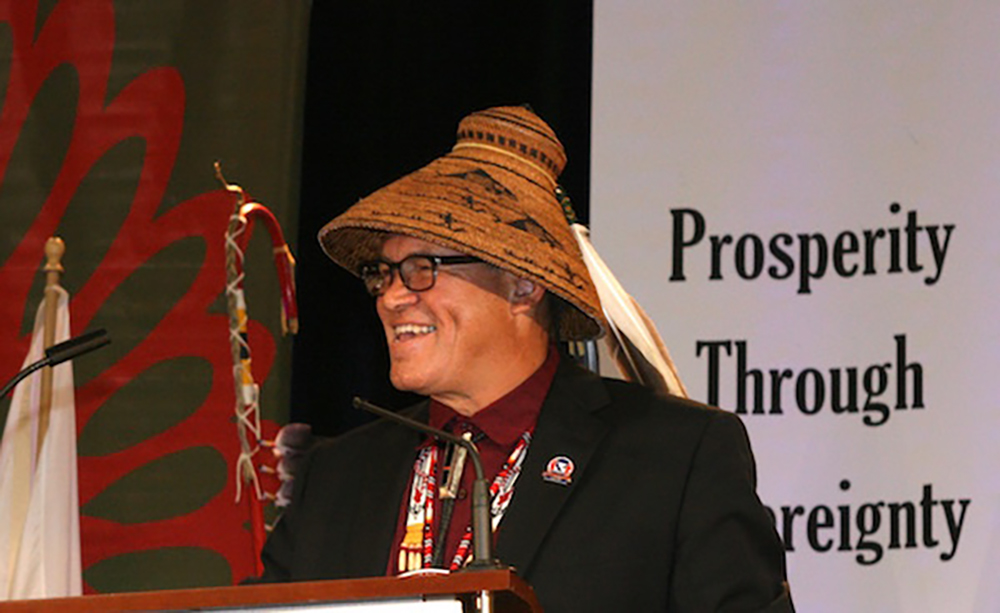
Mary Annette Pember
National Congress of American Indians President Brian Cladoosby opened the NCAI’s 73rd annual convention on October 10.

Courtesy Pechenga
The Pechanga Resort & Casino, owned by the Pechanga Band of Luiseño Indians of southern California, recently received top honors from several national magazines.

Morton County Sheriff's Office
The actress Shailene Woodley, a star of Snowden and other films, was arrested on October 10 at a Dakota Access pipeline protest.

Alex Jacobs at IAIA Museum
Annie Pootoogook, the Inuit creator of “Couple Sleeping” and other works, walked on last month at age 47.
Headlines from the Web
Upcoming Events
October 24-28: Alaska Tribal Conference on Environmental Management
Organized by the Alaska Native Tribal Health Consortium, the conference brings together tribes, non-profit groups, and state and federal organizations, for a week of environmental conversations. The discussions focus on finding and implementing solutions to address the unique environmental concerns facing Alaskan communities. Themes this year are traditional ecological knowledge and environmental values; air quality and healthy homes; water quality and sanitation; climate change; solid waste management; and the repurposing, redevelopment and revitalization of brownfields.
Location: Anchorage Downtown Hilton Hotel, Anchorage, Alaska
October 25-27: Latin American Indigenous Funders Conference
“Buen Vivir: Supporting the Role of Indigenous Peoples In Bio-Cultural Diversity, Human Rights and Sustainable Economic Models” is the theme of this year’s conference. There will be four tracks: 1) Investing in Indigenous Models of Sustainable Development; 2) Protecting Ancestral Territories and Indigenous Rights; 3) Walking in Two Worlds: Why Indigenous Wisdom Will be Vital to Our Future; 4) The How To: Strategies for Support. A half-day pre-conference workshop will focus on Indigenous Peoples and security issues; there will also be a half-day session devoted to Resource Mobilization for Indigenous Women.
Location: Jose Antonio Hotel, Lima, Peru
October 26: Consultation on International Repatriation
This is the third of a series of consultations conducted by the departments of State, Justice and Interior to address the challenge of repatriating Native sacred objects, human remains, objects of cultural patrimony and similar tribal artifacts that are being held in foreign museums or sold abroad. Having established an internal working group to provide assistance and coordination, the Interior Department is now seeking public comment on proposed federal legislation.
Location: Harrah’s Cherokee Hotel and Casino, Cherokee, North Carolina
October 26-27: Aboriginal Trust and Investment Workshop
The workshop is designed to educate and engage participants in discussion on the fundamentals of aboriginal settlement trusts and investment management. Highlights will include comprehensive community planning; requests for the proposal process; understanding investment reporting; and insurance. Continued emphasis will be placed on analysis of impact investing, or how to use both capital and income to effect changes in both particular communities and in the broader aboriginal sector. Conducted by Rodgers Investment Consulting.
Location: Sutton Place Hotel, Vancouver, British Columbia
October 27-30: National/International Native American Indian Alcoholics Anonymous Convention
The annual convention will mark 25 years of carrying the message of AA to its members. The gathering will feature speaker and marathon meetings, talking circles, a banquet and social dance, an “old timers” meeting and a sobriety powwow and social dance, as well as Al-Anon meetings and an Al-Anon brunch.
Location: Buffalo Thunder Resort and Casino, Santa Fe, New Mexico
Letters to the Editor
Re: Dina Gilio-Whitaker’s “What Will ‘Consultation’ Mean for Standing Rock?” (September 29):
If one’s entire knowledge of the United Nations Declaration on the Rights of Indigenous Peoples comes from this article, the author’s conclusion makes perfect sense. If the United States signed an agreement that requires free and informed consent from Indigenous Peoples prior to certain project approvals, then projects such as the Dakota Access pipeline require approval by tribes and not just consultation.
But the author leaves out Article 46 of the declaration: “Nothing in this Declaration may be interpreted as implying for any State, people, group or person any right to engage in any activity or to perform any act contrary to the Charter of the United Nations or construed as authorizing or encouraging any action which would dismember or impair, totally or in part, the territorial integrity or political unity of sovereign and independent States.”
The United States just needs to say that requiring consent for such projects would negatively impact (dismember or impair) its territorial integrity. Such an argument may not be right, but it is probable, and it should have been noted.
—R. Gray

Top News Alerts
SCHAGHTICOKE SUE FOR LOST LAND
The Schaghticoke Tribal Nation is suing the state of Connecticut for land that it says was taken from their reservation beginning more than 200 years ago. The suit, filed on October 13, seeks compensation of at least $613 million for approximately 2,000 acres, reported the Hartford Courant “We’re simply asking the state to do what it promised to do and what it is constitutionally required to do,” said Austin Tighe, a lawyer for the tribe. “Pay the tribe for the land it took.”
NEW ELECTION TO FOLLOW COMANCHE DISPUTE
Following disputes arising from a September 24 election, the Comanche Nation of Oklahoma has scheduled a new election for December 3. According to unofficial results, William Nelson Sr. was elected chairman, with Jonathan Poahway and Eddie Ahdosy securing committee seats. But all three of the losing candidates filed challenges, with Owens charging irregularities after Nelson defeated him by 36 votes. The allegations include bribery, coercion, electioneering and illegally posted campaign literature, reported the Lawton Constitution.
COURT REMOVES CHEROKEE-BACKED CASINO MEASURE
The Arkansas Supreme Court has removed from the November ballot a proposed constitutional amendment, backed by the Cherokee Nation, which would have permitted three new casinos in the state. A judicial panel ruled on October 13 that the title of the initiative includes sports wagering, which by federal law is not allowed in Arkansas. The Cherokee Nation had given $1 million to the Arkansas Wins campaign in hopes of managing a casino in Washington County.
$100,000 IN GRANTS FROM BILLY MILLS
The legendary 1964 Olympic gold medal runner Billy Mills (Oglala Lakota Sioux) has announced the third year of his Dreamstarter grant program, with 10 grants of $10,000 to be awarded to Native youth for projects related to education. Mills and his Running Strong for Indian Youth organization have previously named 20 previous Dreamstarter recipients for projects focused on the themes of “Wellness and “Art and Culture.” Two more years’ worth of grants are scheduled.
COURT DATE LOOMS FOR ‘FRANKENFISH’ LAWSUIT
A lawsuit by 12 plaintiffs, including the Quinault Indian Nation, against several federal agencies concerning last year’s controversial approval of genetically modified salmon, will be heard on November 8. The Quinault joined the case, Institute for Fisheries Resources et al v. Burwell et al, in July. Quinault Nation President Fawn Sharp called the approval by the FDA of a genetically modified animal a violation of the agency’s mandate “to assure that the food and drugs people consume in this country are safe.”
How Did I Miss That?
Gridiron steak discounts, “Trumpkins”
and one tortoise’s bid for freedom
BY STEVE RUSSELL

Dangerous Minds published a photo essay on a new Halloween idea, Trumpkins. Carving a Trump jack-o-lantern starts out with the right color. Then, Dangerous Minds said, the carver must make the mouth look like “an angry anus with teeth.”
We’re not surprised here in the borderlands, where Trump piñatas are still selling out as quickly as they can be made. However, my cousin Ray Sixkiller is worried that if somebody designs one more Trump craft for the holiday season, “We’ll have a shortage of orange paint.”
* * *
CNN Money reported that Carly Simon has, for the first time, allowed “You’re So Vain” to be used in a political ad. She only changed one line. “Your scarf, it was apricot” became “Your skin, it was apricot.” The ad is for Patriotic Artists and Creatives, a superpac supporting Clinton.
* * *
The Detroit Free Press reported that the Ruth’s Cris Steak House in Ann Arbor offered a one percent discount for every point by which the University of Michigan beat Rutgers. It was a nice promotion for home team fans, since the Wolverines were sure to beat the Scarlet Knights. But it wasn’t so great for the steak house when the score came up Michigan 78, Rutgers 0. The terms of the offer cut off the discount at 50 percent, but there were still no reservations to be had at Ruth’s for the duration of the offer.
Cousin Ray suggested that Ruth’s should make the same offer for Clinton’s margin over Trump . . . but that was before the issue turned to groping.
* * *
According to Bloomberg, the Trump campaign got blindsided by things the candidate has said on camera because he did not allow his campaign to do opposition research on himself—a common political tactic to head off surprises from the other side.
Cousin Ray reminded me that Ralph Nader did not have to run such research on himself because of the years he had spent fighting about unsafe automobiles. General Motors already had all the dirt on Nader that was findable.
* * *
Sgt. B. Lovell of the Diboll, Texas Police Department, posted on the DPD Facebook page that he answered an animal call that was “a new one for me.” A 100-pound, 48-year-old tortoise named Sheldon had escaped from a fenced back yard and made a dash for freedom. Well, as much of a dash as a tortoise makes. Sheldon made it about 100 yards before being reported. His people coaxed him to come home with an apple.
* * *
CNN reported on a rather more serious animal call. The Clay County Sheriff’s Office in Florida responded to a 911 call and found a bald eagle left imbedded in a car grille by Hurricane Matthew. The bird was extracted from the grille and taken to the Bird Emergency Aid and Kare Sanctuary. The rescuers named the bird (what else?) Matthew. His injuries are not serious and the plan is to release him as soon as his habitat is no longer overrun with emergency vehicles.
* * *
Joe Scarborough told a great political story on Morning Joe apropos of Donald Trump’s latest anti-constitutional move, whereby he promised that if elected, he will put his political opponent in jail. Scarborough related interviewing Pat Buchanan, who had been a Nixon insider and was political aggression personified. He asked Buchanan why Nixon didn’t demand recounts in 1960 when he knew JFK had stolen Illinois and maybe Texas. “Because,” Buchanan laughed, “we stole Kentucky.”
Election fraud is not funny.
* * *
Also not funny are the two polls from FiveThirtyEight showing what would happen if only women or only men voted. If only women voted, the Electoral College would show 458 electoral votes for Clinton and 80 for Trump. If only men voted, the total would be 188 for Clinton and 350 for Trump. Trump’s response is the hashtag #repealthe19th.
“And people claim Trump isn’t a modern Republican?” Cousin Ray looked like an elephant had stepped on his foot. “If you don’t like how a group of people vote, don’t let them vote. That’s where my party has been lately . . . but without me.” http://bit.ly/2e7pS9B
Upcoming Pow Wows

Red Clay Pow Wow
10/21/16—10/23/16
1140 Red Clay Park
Cleveland, TN
423-240-7270
naservices@gmail.com
NAServices.org
University of Wisconsin-Milwaukee Autumn 39th Annual Pow Wow
10/22/16
2200 East Kenwood Blvd
Milwaukee, WI
414-229-5880
joylogan@uwm.edu
aiss.UWM.edu
Roy Track 33rd Annual Memorial Mesa Pow Wow
10/28/16—10/30/16
525 East Main Street
Mesa, AZ
602-799-0260
roytrack@aol.com
The Big Picture
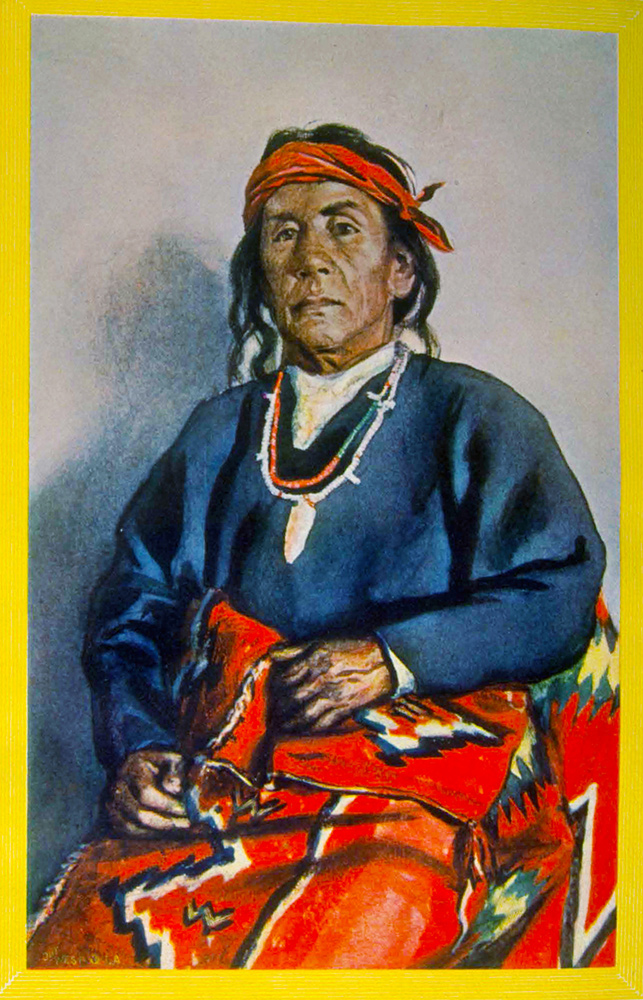

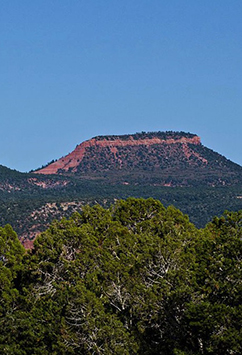

Commentary
A Lethal Agent Orange Legacy
The San Carlos Apache are slowly being choked by chemical death, writes Michael Paul Hill:
In 1962, the San Carlos Apache Tribe permitted the Bureau of Indian Affairs and the U.S. Geological Survey to test the 2-4-5 TP chemicals dioxin and furans, a.k.a. Agent Orange, in the Gila and San Carlos Rivers and in the Pinal Mountains. The reason was to remove salt cedar vegetation along the river and waterways.
But Agent Orange has done nothing to stop the growing of the salt cedars along the river. Instead, we have been invaded with illnesses ranging from birth defects, heart diseases, cancers of all kinds, diabetes, thyroid problems and memory issues such as Alzheimer’s. We were
used as lab rats to test the effects of the chemicals on our bodies and those of our neighbors in the Globe area.
The diseases we now suffer from were never hereditary until their introduction through Agent Orange. It has soaked in the clay sediment strata, thus infecting the vegetation, wildlife, the air we breathe, and the water we drink and bathe in.
Many people are being infected by the death of chemical waters. Millions are drinking poison water and eating poison foods. Yet we are told this is normal and derives from our ancestral heritage. I am sure you have heard the saying, “It’s in our DNA.” Quite the contrary. It is utterly abominable and hideously abnormal.
Living under the shadow of disease and illnesses within our communities only allows future generations to inherit the pain of now, whether it is physical, social, psychological, environmental or, most importantly, spiritual. Accepting the reality that we have been contaminated is the first step toward healing. http://bit.ly/2e4Klw1
The Native Phoniness of Jill Stein
Is Green Party presidential nominee Jill Stein really a legitimate candidate for Native Americans? Terese Maihot has her doubts:
Jill Stein is that white girl who goes to Native functions and gets so outlandish that the cops show up and arrest everyone but her. She looked thrilled to write graffiti on a bulldozer at recent protests against the Dakota Access Pipeline. I’m familiar with that face. It’s the face of tourists when they smudge themselves at our gatherings, or look at our regalia, or do anything that makes for good dinner party fodder or a compelling Facebook status.
Stein gets to congratulate herself and benefit from the exposure, but what has she actually accomplished for Native people? Why are people acting like she’s not an Ivy League graduate and isn’t estimated to be worth millions?
Yes, she’s the only candidate who cares about Indigenous Peoples. But aren’t we familiar with how privileged white people help our community? It becomes paternalistic, nearsighted and downright insulting. I don’t need a tourist to better my circumstance. A true ally doesn’t pose for pictures or walk in the front of the march.
Stein has, outlandishly, entertained anti-vaccine sentiment by parsing and legitimizing the claims that vaccinations can be harmful. I’d like to see her shot records, mostly because I’m sure she’s been inoculated. I wasn’t and I have the tuberculosis to prove it. Because of this, it’s imperative that my children get the shots I needed. If anyone could understand why there should be questions concerning vaccinations, it’s a Native person. After all, we’re familiar with how our own government is capable of putting us at risk.
This all might seem didactic, but I’m living in a theatre of the absurd right now. http://bit.ly/2dW2gpX
A Different Kind Of Wolf Policy
It’s time to reconsider how we perceive wolves as an endangered species, argues Melissa Smith:
Those howling for delisting the wolf as an endangered species in the Western Great Lakes should support reasonable wildlife compromises on their management. Currently there exist in the wolf hunt law no prime habitat protection zones, no tribal authority, and no voice of wolf advocates or cultural consideration of the Ojibwe people.
Indeed, there is widespread recognition of crisis within state agencies nationwide—of legitimacy, best available science and representation. Agency personnel and leaders could find common ground on restructuring how these agencies are funded. Wildlife advocates could also find common ground with promoting revision of the North American Model to better include non-hunting stakeholder interests and greater public involvement.
And leaders of wolf management within state agencies should be enthusiastic allies of certain efforts in Wisconsin, Michigan and Minnesota. These initiatives recognize that some sporting groups, such as the Wisconsin Bear Hunters Association, are aggressively organizing to prevent financial and political reform. We saw this at the Wolf Summit a few weeks ago. In Wisconsin, there are no checks and balances; the state’s Department of Natural Resources (DNR) is a political agency, with a secretary appointed by the governor. The DNR has made clear that public opinion plays no role in its decisions. How does that provide a service and equal protection for state citizens or our wildlife?
Wisconsin’s DNR continues to be dominated by older white males who support sport hunting and fishing over all other management outcomes, and who tend to disregard the input of nontraditional stakeholders. Until public trust is embraced, and the notion of wildlife as a resource for all is accepted, we can’t energize a new wildlife constituency.
http://bit.ly/2dfXALz